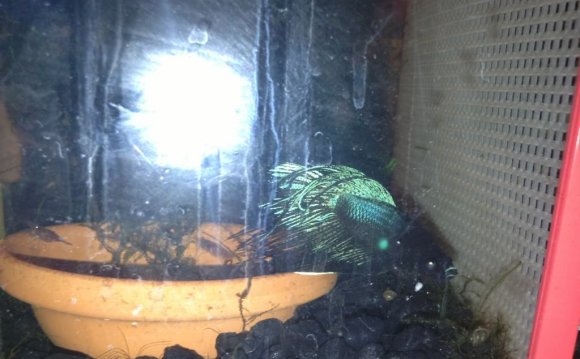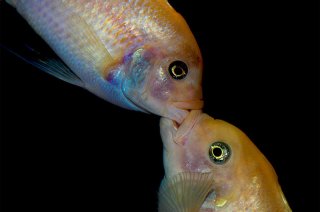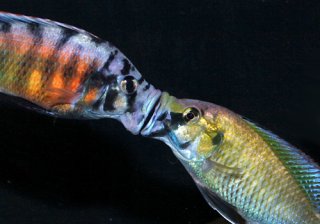
 What is it that draws aquarium enthusiasts to Chichlids? What else, but our adoration of their spectacular colours and their unique mannerisms! Or could it be that we all admire their extrovert personalities, their intricate social behavior and the astonishing degree of intelligence they possess? Or could it just possibly be that their most famous trait — aggression — sometimes so perfectly mirrors our own?
What is it that draws aquarium enthusiasts to Chichlids? What else, but our adoration of their spectacular colours and their unique mannerisms! Or could it be that we all admire their extrovert personalities, their intricate social behavior and the astonishing degree of intelligence they possess? Or could it just possibly be that their most famous trait — aggression — sometimes so perfectly mirrors our own?
Lake Malawi is Africa’s third largest and second deepest lake, and also the world’s tenth largest freshwater lake. The 1000 species, or more, of Lake Malawi cichlids include some of the most beautiful fish in the world, fresh water or otherwise. Indeed, African cichlids are known in particular for their beautiful array of colors and patterns.
Lake Tanganyika lies in the great rift basin of East Central Africa, and is the seventh largest, and the second deepest freshwater lake in the world, with approximately 250 different Cichlid species and more than 150 species of other fish. Moreover, the lake has two record breaking dwellers, the world’s largest Cichlid with a length of 80 cm and the world’s smallest Cichlid that is only 3.5 cm long. The area of the East African Rift Valley has active volcanoes, which makes the lake water quite alkaline, but also very rich in minerals. It is important to keep this natural habitat in mind if you plan to keep Lake Tanganyika Cichlids. Within this lake there are three main biotopes:
- Open water with a sandy substrate.
- Rocky substrate, located around parts of the shoreline and also underwater reefs and
- Shell beds, found in the form of piles of empty snail shells that litter the floor in different bays.
 Different kinds of Cichlids evolved from each biotope and are therefore attracted to exploit that particular environment. The Lake Tanganyika Cichlids thus differ in body shape from the uniform shape of Lake Malawi Cichlids, and also differ greatly in their feeding habits.
Different kinds of Cichlids evolved from each biotope and are therefore attracted to exploit that particular environment. The Lake Tanganyika Cichlids thus differ in body shape from the uniform shape of Lake Malawi Cichlids, and also differ greatly in their feeding habits.
Lake Victoria is in Central Africa, and is the third largest freshwater lake in the world. The lake has a large variety of Haplochromines and a few Tilapines.
It is important to remember that each of these lakes have their own definite water parameters, which you should always heed, depending on which Cichlid species you want to keep. We will provide a table of these parameters at the end of the cichlid pages.
The Cichlids of Africa, renowned for their proliferation, are among the easiest aquarium fish to breed. With very few exceptions, African Cichlids, especially those fromLake Malawi, readily adapt to life in captivity. They are very hardy, and they are easy to maintain – but to keep and display them at their best, they do require relatively large aquariums with the kind of aquascaping that not only allows plenty of space for swimming, but takes accord of definitive delineation between areas, as well as caves and plenty of hideaways, to ease territorial possession.
 However, if you want to keep Cichlids, you will need to learn how to read and understand their colour changes. Cichlids express dominance or timidity through their coloration: a pale fish may be a stressed or submissive fish, whereas a bright fish usually is a dominant or aggressive fish – and always the number one choice for mates. During breeding the males become flamboyant. When males lose their territory, they also lose their bright colouring. However, some try another ploy: They go into hiding, but retain their colours to pretend that they are still dominant, so hoping to attract potential mates.
However, if you want to keep Cichlids, you will need to learn how to read and understand their colour changes. Cichlids express dominance or timidity through their coloration: a pale fish may be a stressed or submissive fish, whereas a bright fish usually is a dominant or aggressive fish – and always the number one choice for mates. During breeding the males become flamboyant. When males lose their territory, they also lose their bright colouring. However, some try another ploy: They go into hiding, but retain their colours to pretend that they are still dominant, so hoping to attract potential mates.
African Cichlids are highly predatory and extremely territorial. In the wild, they often live together in groups or schools of like species. Mature Cichlids guard their territory and they are not hospitable at all – frequently behaving aggressively to con-specifics, and especially to Cichlids of a different species, but a similar colouring. In nature all is not perfect as we sometimes think – fish do die from conflicts and disputes. But in an aquarium, Cichlid aggression can be your biggest headache!
While aggression is probably one of the hardest aspects of African Cichlids to deal with, many ingenious hobbyists have overcome, or at least subdued aggression to the point where a relatively tolerant community can be had. In all honesty, Cichlids show their most vibrant colours and pugnacious attitude during disputes - so the goal is not really to destroy ALL of this activity, but to limit it to the point where you don’t wake up every morning with a “victim” floating at the surface.
While not all Cichlids are super-aggressive, and many are even outright docile, there is a definite hierarchy in the cichlid aquarium. The largest Cichlid is usually the dominant one and will behave aggressively towards all of the other inhabitants. During mating and territorial disputes, this aggression can progress to tail beating, as the dominant Cichlid attempts to push water at its enemy to show off its power. If he has a defiant opponent, this situation can and often does escalate into to genuine combat, which can include mouth-locked wrestling and a lot chasing in an attempt to bite each other. If this behavior persists you may have to separate the warriors, for it will surely go on till one dies. The smallest Cichlids in the aquarium may also occasionally be attacked and even killed by the larger, more dominant fish.
However, aggressive behaviour can be dealt with in five ways. (I urge beginners to pay attention here – just as I recommend this section for Cichlid keepers who have recurring aggression problems)









